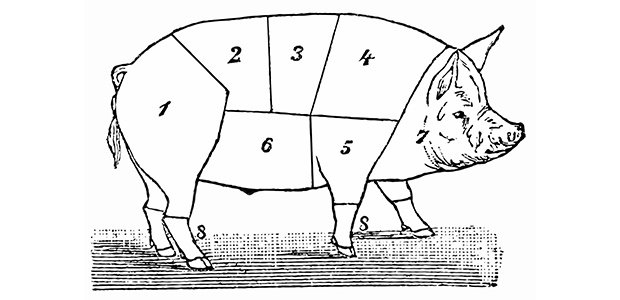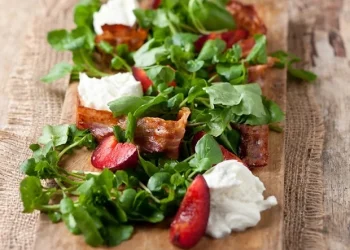Cape Town foodies are excited about La Tête, the new restaurant that has recently opened at the bottom of Bree Street. It’s also been named by CNN as one of 2017’s best new restaurants!
The focus at this new eatery is nose to tail eating. ‘Nose to tail’ not a new term, and other restaurants in Cape Town have used the phrase to describe their philosophy. But chef-proprietor of La Tête, Giles Edwards, has spent the last few years working in the kitchen at Michelin-starred London restaurant, St John, under chef Fergus Henderson who is considered one of the pioneers of the modern nose to tail movement.
READ: Review of La Tête on Bree Street
Nose to tail refers to the preparation and consumption of the whole animal as opposed to just the choice parts. If you were to purchase a butchered half lamb or full lamb, you would have a selection of cuts to use. Some would be the very popular pieces like the shanks or legs for roasting. Others would be less tender parts which would be used in stews or curries or other slow-cooked dishes. But what you would seldom receive is the brain, tail, offal, etc. Those parts are unpopular these days, but nose to tail requires that even the unpopular parts of the animal be used.
Nose to tail is not a new way of eating, but rather a return to a more traditional way of eating that respects the animal rather than makes it a commodity in a factory-style system of production and consumption. My paternal grandparents were farmers in Asturias, a province in northern Spain. It was, and still is, a very rural area. They had no electricity and the nearest large town was quite some way away so they were mostly self-sufficient.
They were dairy farmers, the sale of milk provided the currency the family needed for things they could not make or trade themselves. They kept chickens, rabbits and pigs. Every 6 months a pig would be slaughtered and they would use the whole animal. They would make jamon (cured ham) and chorizo, sausages and various other things. The snout, ears, cheeks, tail, trotters and such things were prized parts.
They reared the animal, fed it and looked after it. They knew its name, they slaughtered it themselves and they used every last bit of it. That was respectful to the animal. But it would be naïve to ignore the fact that the primary reason for their modus operandi was financial. Meat was a luxury in those days, only in the last couple of decades has eating large amounts of meat become the norm in many parts of the world. People had to use the whole animal as it was just too expensive to waste any of it.
The cost of meat has decreased due to efficiencies in large scale production and the externalising of costs such as the environmental impact. Combined with the increase of average per capita income, particularly in first world countries, this has resulted in a massive increase in the consumption of meat. What was perhaps a weekly occurrence had become a daily occurrence, even several times per day. This excessive meat consumption has taken a significant toll on the environment and the factory style rearing of the animals has led to sincere concerns about the well-being of the animals.
Socially and ethically conscious consumers have become concerned with the impact of meat consumption and there is a trend to eat less meat, eat ethical meat (free range, grass-fed) and eat the whole animal. South Africa, being a mix of first and third world has a slightly different situation where there is a part of the population which can afford to eat only the choice parts of the animal, but rather than the rest of the animal going to waste, as it is in other countries, it is consumed by the part of the population for which meat is a luxury.
For this reason some may argue that the nose to tail philosophy does not serve much purpose in South Africa. However, nose to tail is not just a dietary choice but also a philosophy. According to Giles Edwards of La Tête, cooking and eating nose to tail is about changing the mindset of unconscious consumption and embracing a more sustainable way of living. Nose to tail eating is only one lifestyle change among others such as recycling, avoiding bottled water and various other changes which benefit the environment and reflect a more responsible existence on this planet.
Cooking and eating nose to tail definitely takes both chef and diner out of their comfort zone. Chefs need to make different dishes as they prepare different parts of the animal, changing the menu as often as daily. Chefs that subscribe to the philosophy of nose to tail will generally also go to the effort of sourcing local and seasonal ingredients. This means that a liver dish in Winter will be different to a liver dish in Summer due to the seasonal ingredients being different.
Diners need to step outside of their comfort zones and instead of ordering the same dishes or cuts of meat, be prepared to order different dishes and unusual parts of the animal. For some, the idea of eating brains or tongue is just too unappealing for them, but often these parts can be prepared in a way which is palatable even for the most squeamish of diners. What one can take for granted, is that it will be delicious.
Chefs that are prepared to take on the challenge of cooking nose to tail using seasonal ingredients will generally be accomplished chefs with the knowledge and experience to do it well. Experiencing the dishes prepared by these chefs will be a culinary journey and education which will leave the diner with a greater appreciation for the art of cooking nose to tail and a sense of well-being in the knowledge that they, in a small way, have distanced themselves from the consumption frenzy that is destroying the planet.
READ: Review of La Tête on Bree Street
Follow Dax on Twitter and Instagram















